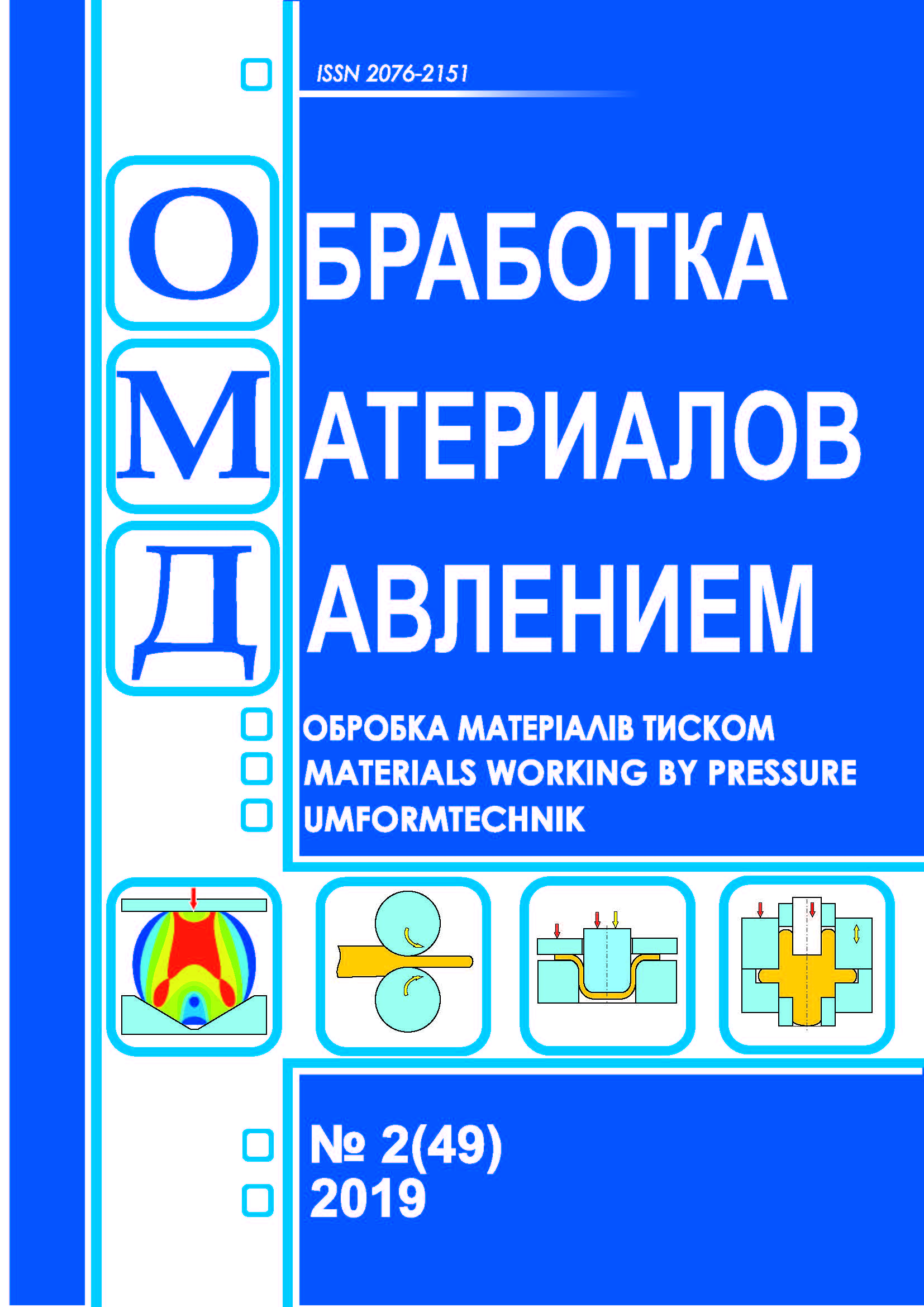Simulation of the material of a cylindrical billet with a weld during crimping
DOI:
https://doi.org/10.37142/2076-2151/2019-2(49)55Keywords:
cylindrical billet; weld seam; plastic deformation; stresses; model; distribution; anisotropy; secant modulus.Abstract
Puzyr R. G., Dragobetsky V. V., Levchenko R. V., Siraya Yu. B. Simulation of the material of a cylindrical billet with a weld during crimping // Material working by pressure. – 2019. – № 2 (49). - Р. 55-60.
It is shown that the distribution of the ends of tubular billets is accompanied by a loss of stability in the circumferential and axial directions, as well as localization of deformations, followed by destruction in the form of a longitudinal crack that occurs at the end of the preform. The presence of the weld complicates the general conditions of deformation during crimping and distribution and leads to the destruction of the workpiece along the weld. To prevent cracking, it is necessary to tighten the crimping and distributing factors, which inevitably leads to an increase in the number of transitions, the complexity of the process and the cost of manufacturing the part as a whole. The issue of deformation of welded structures is of interest with the development of new materials for the automotive industry, such as joining two or more steel sheets with different mechanical properties, thickness or type of coating, which are important for reducing weight, minimizing costs and reducing scrap. It is shown that the deformation of the pipe billet will depend not only on the plasticity characteristics of the base metal and the weld metal, which is obvious, but also on the ratio of the squares of the pipe billet. The increase in the above modulus of plasticity is accompanied by hardening of the welded joint compared with the initial metal of the workpiece, respectively, a decrease in the value of the secant modulus in both directions – a decrease in the strength characteristics of the weld metal. Further analysis of the deformation of the welded workpiece should be carried out taking into account the local anisotropy caused by the welding seam, which will make it possible to determine the conditions of sustained plastic deformation and create an additional effect on the weakened area.
References
Popov E.A. Fundamentals of the theory of sheet stamping. Moscow: Mechanical Engineering. 1977, 278 p. (in Russian).
Puzyr R.G., Trotsko O.V., Cherkaschenko V.Yu. Influence of the geometrical parameters of a cylindrical billet on the stress-strain state during distribution by conical punches. Materials Working by Pressure. Kramatorsk: DSEA. 2012, 4(33), pp. 114–121. (in Russian).
Averkiev Yu.A., Averkiev A.Yu. Technology of cold stamping. Moscow: Mechanical Engineering. 1989, 304 p. (in Russian).
Dragobetsky V.V., Boyko Yu.A., Bubble R.G. Description of the process of shaping welded billets. Bulletin of the KSPU M. Ostrogradsky. 2008, 2, pp. 79–83. (in Russian).
Yakovlev S.P., Kukhar V.D. Stamping of anisotropic materials. Moscow: Mechanical Engineering. 1986. 136 p. (in Russian).
Moroz N.N., Dragobetsky V.V., Boyko Yu.A. The ultimate degree of deformation in the calculation of welded cylindrical billets for the manufacture of wheel rims. Bulletin of the KSPU M. Ostrogradsky. 2009, 6, pp. 63–65. (in Russian).
Qiu X.G., Chen W.L. The study on numerical simulation of the laser tailor welded blanks stamping. Journal of Materials Processing Technology. 2007, 187, pp. 128–131. DOI: https://doi.org/10.1016/j.jmatprotec.2006.11.128
Mohebbi M., Akbarzadeh A. Prediction of formability of tailor welded blanks by modification of MK model. International Journal of Mechanical Sciences. 2012, 61(1), pp. 44–51.
Puzyr R., Haikova T., Trotsko O., Argat R. Determining experimentally the stress-strained state in the radial rotary method of obtaining wheels rims. Eastern European Journal of Enterprise Technologies. 2016, 1, pp. 52–60.
Puzyr R., Savelov D., Argat R., Chernish A. Distribution analysis of stresses across the stretching edge of die body and bending radius of deforming roll during profiling and drawing of cylindrical workpiece. Metallurgical and Mining Industry. 2015, 1, pp. 27–32.
Dragobetsky V.V., Levchenko R.V., Puzyr R.G. Analysis of the loading of a workpiece with a radial-rotational method for producing wheel rims with a modified external action pattern. Materials Working by Pressure. Kramatorsk: DSEA. 2012, 1(30), pp. 146–149. (in Russian).
Puzyr R.G., Mospan D.V., Dragobetsky V.V. Determination of the required torque for radial-rotational profiling of wheel rims. Bulletin of the KSPU M. Ostrogradsky. Kremenchuk. 2008, 6, pp. 64–66. (in Russian).
Puzyr R.G. Calculation of the components of the stress tensor at the second transition of the radial-rotational profiling of the rims of the wheels of vehicles. Materials Working by Pressure. Kramatorsk: DSEA. 2016, 1(42), pp. 164- 168. (in Russian).
Puzyr R.G., Dolgikh O.N., Gritsenko B.S., Dikaya L.E. Distribution of stresses on the conical section of the semi-finished product profile of the first transition of radial-rotational profiling. Bulletin of the KNU M. Ostrogradsky. Kremenchuk. 2015, 39, pp. 67–73. (in Russian).
Puzyr R.G., Dikaya L.E. Accounting for the hardening of metal in determining the zone of possible annular loss of stability in the first distribution operation in the manufacture of wheel rims. Bulletin of the KhNTU. Kherson. 2015, 3, pp. 165–169. (in Russian).
Sosenushkin E.N., Yanovskaya E.A., Khachatryan D.V., Smolovich I.E., Kinderov V.Yu. Analysis of the process of distribution of pipe billets during stamping of products with conical surfaces. Materials Working by Pressure. Kramatorsk: DSEA. 2013, 2(35), pp. 135–141. (in Russian).
Kalyuzhny A.V., Pimanov V.V., Oleksandrenko Ya.S., Kulikov I.P. Intensification of the process of distribution of axisymmetric tubular billets. Materials Working by Pressure. Kramatorsk: DSEA. 2014, 1(38), pp. 103- 108. (in Russian).
Avdonin A.S. Applied methods for calculating shells and thin-walled structures. Moscow: Mechanical Engineering. 1969, 405 p. (in Russian).

